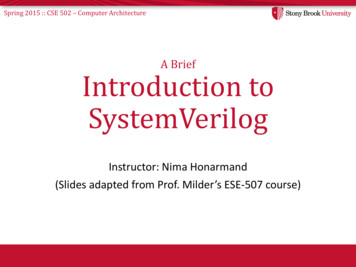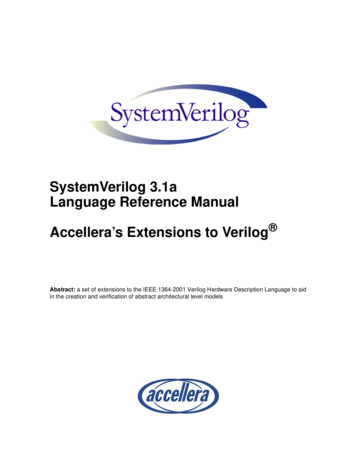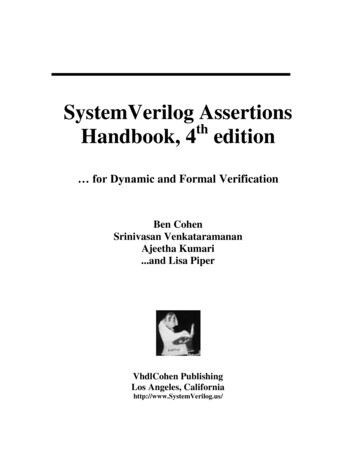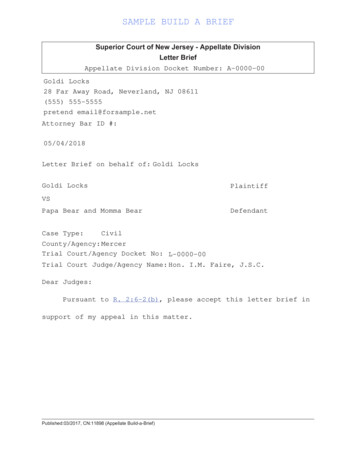
Transcription
Spring 2015 :: CSE 502 – Computer ArchitectureA BriefIntroduction toSystemVerilogInstructor: Nima Honarmand(Slides adapted from Prof. Milder’s ESE-507 course)
Spring 2015 :: CSE 502 – Computer ArchitectureFirst Things First Assume you are familiar with the basics of digitallogic design– If not, you can read Appendix A of Hamacher et al. SystemVerilog is a superset of another HDL: Verilog– Familiarity with Verilog (or even VHDL) helps a lot Useful SystemVerilog resources and tutorials on thecourse project web page– Including a link to a good Verilog tutorial
Spring 2015 :: CSE 502 – Computer ArchitectureHardware Description Languages Used for a variety of purposes in hardware design– High-level behavioral modeling– Register Transfer Level (RTL) behavioral modeling– Gate and transistor level netlists– Timing models for timing simulation– Design verification and testbench development– Many different features to accommodate all of these We focus on RTL modeling for the course project– Much simpler than designing with gates– Still, helps you think like a hardware designer
Spring 2015 :: CSE 502 – Computer ArchitectureHDLs vs. Programming Languages Have syntactically similar constructs:– Data types, variables, assignments, if statements, loops, But very different mentality and semantic model:everything runs in parallel, unless specified otherwise– Statement model hardware– Hardware is inherently parallel Software programs are composed of subroutines(mostly)– Subroutines call each other– when in a callee, the caller’s execution is paused Hardware descriptions are composed of modules (mostly)– A hierarchy of modules connected to each other– Modules are active at the same time
Spring 2015 :: CSE 502 – Computer ArchitectureModules The basic building block in SystemVerilog– Interfaces with outside using ports– Ports are either input or output (for now)module namedeclare whichports are inputs,which are outputsall ports declared heremodule mymodule(a, b, c, f);output f;input a, b, c;// Description goes hereendmodule// alternativelymodule mymodule(input a, b, c, output f);// Description goes hereendmodule5
Spring 2015 :: CSE 502 – Computer ArchitectureModule Instantiationname ofmodule toinstantiatemodule mymodule(a, b, c, f);output f;input a, b, c;module name inst name(port connections);endmodulename ofinstanceconnect the ports You can instantiate your own modules or pre-defined gates– Always inside another module Predefined: and, nand, or, nor, xor, xnor– for these gates, port order is (output, input(s)) For your modules, port order is however you defined it6
Spring 2015 :: CSE 502 – Computer ArchitectureConnecting Ports (By Order or Name) In module instantiation, can specify port connectionsby name or by ordermodule mod1(input a, b, output f);// .endmodule// by ordermodule mod2(input c, d, output g);mod1 i0(c, d, g);endmodule// by namemodule mod3(input c, d, output g);mod1 i0(.f(g), .b(d), .a(c));endmoduleAdvice: Useby-nameconnections(where possible)7
Spring 2015 :: CSE 502 – Computer ArchitectureCombinational LogicDescription
Spring 2015 :: CSE 502 – Computer ArchitectureStructural Design Example: multiplexor– Output equals an input– Which one depends on “sel”module mux(a, b, sel, f);output f;input a, b, sel;datatype for describing logical valuelogic c, d, not sel;not gate0(not sel, sel);and gate1(c, a, not sel);and gate2(d, b, sel);or gate3(f, c, d);endmoduleBuilt-in gates:port order is:output, input(s)
Spring 2015 :: CSE 502 – Computer ArchitectureContinuous Assignment Specify logic behaviorally by writing an expressionto show how the signals are related to each other.– assign statementdmodule mux2(a, b, sel, f);output f;input a, b, sel;logic c, d;assign c a & ( sel);assign d b & sel;assign f c d;c// or alternativelyassign f sel ? b : a;endmodule10
Spring 2015 :: CSE 502 – Computer ArchitectureCombinational Procedural Block Can use always comb procedural block todescribe combinational logic using a series ofsequential statementsmymodule(a, b, c, f); All always comb moduleoutput f;blocks areinput a, b, c;independent andalways comb beginparallel to each other// Combinational logic// described// in C-like syntaxendendmodule
Spring 2015 :: CSE 502 – Computer ArchitectureProcedural Behavioral Mux Descriptionmodule mux3(a, b, sel, f);output logic f;input a, b, sel;always comb beginif (sel 0) beginf a;endelse beginf b;endendendmoduleIf we are going to drive f thisway, need to declare it as logicImportant: for behavior to becombinational, every output (f)must be assigned in all possiblecontrol pathsWhy? Otherwise, would be a latchand not combinational logic.
Spring 2015 :: CSE 502 – Computer ArchitectureAccidental Latch Descriptionmodule bad(a, b, f);output logic f;input a, b;always comb beginif (b 1) beginf a;endendendmodule This is notcombinational, becausefor certain values of b, fmust remember itsprevious value. This code describes alatch. (If you want alatch, you should defineit usingalways latch)
Spring 2015 :: CSE 502 – Computer ArchitectureMultiply-Assigned Valuesmodule bad2(.);.always comb beginb . something .endalways comb beginb . something else .endendmoduleDon’t do this! Both of theseblocks executeconcurrently So what is thevalue of b?We don’t know!
Spring 2015 :: CSE 502 – Computer ArchitectureMulti-Bit Values Can define inputs, outputs, or logic with multiple bitsmodule mux4(a, b, sel, f);output logic [3:0] f;input [3:0] a, b;input sel;always comb beginif (sel 0) beginf a;endelse beginf b;endendendmodule
Spring 2015 :: CSE 502 – Computer ArchitectureMulti-Bit Constants and Concatenation Can give constants with specified number bits– In binary or hexadecimal Can concatenate with { and }logic [3:0] a, b, c; Canreverseorderlogicsigned[3:0]d; (to index buffers left-to-right)logic [7:0] e;logic [1:0] f;assign a 4’b0010;// four bits, specified in binaryassign b 4’hC;// four bits, specified in hex 1100assign c 3;// 0011assign d -2;// 2’s complement 1110 as bitsassign e {a, b};// concatenate 0010 1100assign f a[2 : 1]; // two bits from middle 01
Spring 2015 :: CSE 502 – Computer ArchitectureCase Statements and “Don’t-Cares”module newmod(out, in0, in1, in2);input in0, in1, in2;output logic out;always comb begincase({in0, in1, in2})3'b000: out 1;3'b001: out 0;3'b010: out 0;3'b011: out x;3'b10x: out 1;default: out 0;endcaseendendmoduleoutput value isundefined in this caseLast bit is a “don’tcare” -- this line willbe active for 100 OR101default gives “else”behavior. Here activeif 110 or 111
Spring 2015 :: CSE 502 – Computer ArchitectureArithmetic Operators Standard arithmetic operators defined: - * / % Many subtleties here, so be careful:– four bit number four bit number five bit number Or just the bottom four bits– arbitrary division is difficult
Spring 2015 :: CSE 502 – Computer ArchitectureAddition and Subtraction Be wary of overflow!logic [3:0] d, e, f;logic [3:0] a, b;logic [4:0] c;assign f d e;assign c a b;4’b1000 4’b1000 In this case, overflows to zero Use “signed” if you wantvalues as 2’scomplementi 4’b1010 -6j 5’b11010 -6Five bit output can prevent overflow:4’b1000 4’b1000 gives 5’b10000logic signed [3:0] g, h, i;logic signed [4:0] j;assign g 4’b0001; // 1assign h 4’b0111; // 7assign i g – h;assign j g – h;
Spring 2015 :: CSE 502 – Computer ArchitectureMultiplication Multiply k bit number with m bit number– How many bits does the result have? k mlogic signed [3:0] a, b;logic signed [7:0] c;assign a 4'b1110; // -2assign b 4'b0111; // 7assign c a*b;c 8’b1111 0010 -14 If you use fewer bits in your code– Gets least significant bits of the productlogic signed [3:0] a, b, d;assign a 4'b1110; // -2assign b 4'b0111; // 7assign d a*b;d 4’0010 2Underflow!
Spring 2015 :: CSE 502 – Computer ArchitectureSequential LogicDescription
Spring 2015 :: CSE 502 – Computer ArchitectureSequential Design Everything so far was purely combinational– Stateless What about sequential systems?– flip-flops, registers, finite state machines New constructs– always ff @(posedge clk, )– non-blocking assignment
Spring 2015 :: CSE 502 – Computer ArchitectureEdge-Triggered Events Variant of always block called always ff– Indicates that block will be sequential logic (flip flops) Procedural block occurs only on a signal’s edge– @(posedge ) or @(negedge )always ff @(posedge clk, negedge reset n) begin// This procedure will be executed// anytime clk goes from 0 to 1// or anytime reset n goes from 1 to 0end
Spring 2015 :: CSE 502 – Computer ArchitectureFlip Flops (1/3) q remembers what d was at the last clock edge– One bit of memory Without reset:module flipflop(d, q, clk);input d, clk;output logic q;always ff @(posedge clk) beginq d;endendmodule
Spring 2015 :: CSE 502 – Computer ArchitectureFlip Flops (2/3) Asynchronous reset:module flipflop asyncr(d, q, clk, rst n);input d, clk, rst n;output logic q;always ff @(posedge clk, negedge rst n) beginif (rst n 0)q 0;elseq d;endendmodule
Spring 2015 :: CSE 502 – Computer ArchitectureFlip Flops (3/3) Synchronous reset:module flipflop syncr(d, q, clk, rst n);input d, clk, rst n;output logic q;always ff @(posedge clk) beginif (rst n 0)q 0;elseq d;endendmodule
Spring 2015 :: CSE 502 – Computer ArchitectureMulti-Bit Flip Flopmodule flipflop asyncr(d, q, clk, rst n);input [15:0] d;input clk, rst n;output logic [15:0] q;always ff @(posedge clk, negedge rst n) beginif (rst n 0)q 0;elseq d;endendmodule
Spring 2015 :: CSE 502 – Computer ArchitectureDigression: Module Parameters Parameters allow modules to be easily changedmodule my flipflop(d, q, clk, rst n);parameter WIDTH 16;input [WIDTH-1:0] d;input clk, rst n;output logic [WIDTH-1:0] q;.endmodule Instantiate and set parameter:default value set to 16uses default valuemy flipflop f0(d, q, clk, rst n);my flipflop #(12) f0(d, q, clk, rst n);changes parameter to12 for this instance
Spring 2015 :: CSE 502 – Computer ArchitectureNon-Blocking Assignment a b; is the non-blocking assignment operator– All left-hand side values take new values concurrentlyalways ff @(posedge clk) beginb a;c b;end This models synchronous logic!c gets the old value of b, notvalue assigned just above
Spring 2015 :: CSE 502 – Computer ArchitectureNon-Blocking vs. Blocking Use non-blocking assignment to describeedge-triggered (synchronous) assignmentsalways ff @(posedge clk) beginb a;c b;end Use blocking assignment to describecombinational assignmentalways comb beginb a;c b;end
Spring 2015 :: CSE 502 – Computer ArchitectureDesign Example Let’s say we want to compute f a b*c– b and c are 4 bits, a is 8 bits, and f is 9 bits First, we will build it as a combinational circuit Then, we will add registers at its inputs and outputs
Spring 2015 :: CSE 502 – Computer ArchitectureFinite State Machines (1/2)reset State names0 Output valuesA/001 Transition values Reset state0B/00D/101010C/111
Spring 2015 :: CSE 502 – Computer ArchitectureFinite State Machines (2/2) What does an FSM look like when implemented? Combinational logic and registers (things wealready know how to do!)
Spring 2015 :: CSE 502 – Computer ArchitectureFull FSM Example (1/2)resetmodule fsm(clk, rst, x, y);input clk, rst, x;output logic [1:0] y;enum { STATEA 2'b00, STATEB 2'b01, STATEC 2'b10,STATED 2'b11 } state, next state;// next state logicalways comb begincase(state)STATEA: next stateSTATEB: next stateSTATEC: next stateSTATED: next stateendcaseend0A/0010D/10B/001 xxxx?// . continued on next TEA;STATEB;010C/111
Spring 2015 :: CSE 502 – Computer ArchitectureFull FSM Example (2/2)// . continued from previous slide// registeralways ff @(posedge clk) beginif (rst)state STATEA;elsestate next state;end// Output logicalways comb begincase(state)STATEA: y 2'b00;STATEB: y 2'b00;STATEC: y 2'b11;STATED: y /111
Spring 2015 :: CSE 502 – Computer ArchitectureArraysmodule multidimarraytest();logic [3:0] myarray [2:0];assign myarray[0] 4'b0010;assign myarray[1][3:2] 2'b01;assign myarray[1][1] 1'b1;assign myarray[1][0] 1'b0;assign myarray[2][3:0] 4'hC;initial begin display("myarray %b", display("myarray[2:0] %b", display("myarray[1:0] %b", display("myarray[1] %b", display("myarray[1][2] %b", display("myarray[2][1:0] ];myarray[1]);myarray[1][2]);myarray[2][1:0]);
Spring 2015 :: CSE 502 – Computer ArchitectureMemory (Combinational read)module mymemory(clk, data in, data out,r addr, w addr, wr en);parameter WIDTH 16, LOGSIZE 8;localparam SIZE 2**LOGSIZE;input [WIDTH-1:0] data in;output logic [WIDTH-1:0] data out;input clk, wr en;input [LOGSIZE-1:0] r addr, w addr;logic [WIDTH-1:0] mem [SIZE-1:0];Combinational readassign data out mem[r addr];always ff @(posedge clk) beginif (wr en)mem[w addr] data in;endendmoduleSynchronous write
Spring 2015 :: CSE 502 – Computer ArchitectureMemory (Synchronous read)module mymemory2(clk, data in, data out,r addr, w addr, wr en);parameter WIDTH 16, SIZE 256;localparam SIZE 2**LOGSIZE;input [WIDTH-1:0] data in;output logic [WIDTH-1:0] data out;input clk, wr en;input [LOGSIZE-1:0] r addr, w addr;logic [WIDTH-1:0] mem [SIZE-1:0];always ff @(posedge clk) begindata out mem[r addr];if (wr en)mem[w addr] data in;endendmoduleSynchronous readWhat happens if wetry to read and writethe same address?
Spring 2015 :: CSE 502 – Computer ArchitectureAssertions Assertions are test constructs– Automatically validated as design is simulated– Written for properties that must always be true Makes it easier to test designs– Don’t have to manually check for these conditions
Spring 2015 :: CSE 502 – Computer ArchitectureExample: A Good Place for Assertions Imagine you have a FIFO queue– When queue is full, it sets status full to true– When queue is empty, it sets status empty to truedata inwr enrd endata outFIFOstatus fullstatus empty When status full is true, wr en must be false When status empty is true, rd en must be false
Spring 2015 :: CSE 502 – Computer ArchitectureAssertions A procedural statement that checks an expression whenstatement is executedUse displayto print text, error toprint error, or fatal toprint and haltsimulation// general formassertion name: assert(expression) pass code;else fail code;// examplealways @(posedge clk) beginassert((status full 0) (wr en 0))else error("Tried to write to FIFO when full.");end SV also has Concurrent Assertions that are continuouslymonitored and can express temporal conditions– Complex but very powerful– See assertions/for an introduction
SystemVerilog is a superset of another HDL: Verilog –Familiarity with Verilog (or even VHDL) helps a lot Useful SystemVerilog resources and tutorials on the course project web page –Including a link to a good Verilog










